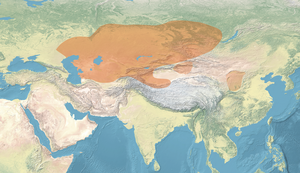51°47′00″N 94°45′00″E / 51.783333°N 94.75°E
General location of the Aldy-Bel culture within the Saka realm ( ), and main contemporary polities c. -500 | |
| Geographical range | South Siberia |
|---|---|
| Dates | 7th to 6th centuries BCE.[1] |
| Preceded by | Arzhan culture |
| Followed by | Sagly-Bazhy culture, Pazyryk culture, Tagar culture |

The Aldy-Bel culture (Russian: Алды-бельская культура Aldy-Bel'skaya kul'tura) was part of Uyuk culture (Russian: Уюкская культура культура Uyukskaya kul'tura), and is an Iron Age culture of Scytho-Siberian horse nomads in the area of Tuva in southern Siberia, dated to the 8th to 6th centuries BCE.[1][3]
Monuments of the Aldy-Bel culture were identified by A.D. Grach and I.U. Sambu and published in 1971. The culture is named after the site of the Aldy-Bel I kurgan. More than 30 kurgan burial complexes are identified within the Aldy-Bel culture.
The culture was contiguous with the nomadic Pazyryk culture in the area of Altai Mountains in South Siberia.
The monuments of the Aldy-Bel culture are synchronous and in many respects similar with those of the Mayemir culture in the Altai region and the Tasmola culture of Central Kazakhstan. The geographical spread covers the right bank of the Yenisei south of the Uyuk ridge, the Khemchik River, deep into the Sayan Canyon and the Western Sayan. Typologically, the monuments are adjacent to similar kurgan burials in different areas of Tuva.
D.G. Savinov theorizes that, at the end of the 8th or beginning of the 7th century BCE, the Aldy-Bel people were part of the Arzhan tribal union that formed the Aldy-Bel culture and was headed by a ruling dynasty. The Arzhan royal kurgan is located in the area south of the Uyok ridge and is connected by passages with the main area of the Aldy-Bel culture. The proximity of the Aldy-Bel tribes probably accounted for close ethnic connections of the Arzhan people with the Aldy-Bel people. After the fall of the Arzhan tribal alliance, the Aldy-Bel people retained their independence for a long time, at least throughout 8th and 6th centuries BC, but because of peculiarities of their social organization, there did not arise an elite ruling layer similar to the Arzhan dynasty among them.[4]
- ^ a b Alekseev, A.Yu. (2001). "A chronology of the Scythian antiquities of Eurasia based on new archaeological and C-14 data". Radiocarbon. 43 (2B): 1092. Bibcode:2001Radcb..43.1085A. doi:10.1017/S0033822200041746. S2CID 53965098.
- ^ Pilipenko, Aleksandr S. (20 September 2018). "Maternal genetic features of the Iron Age Tagar population from Southern Siberia (1st millennium BC)". PLOS ONE. 13 (9): e0204062. Bibcode:2018PLoSO..1304062P. doi:10.1371/journal.pone.0204062. ISSN 1932-6203. PMC 6147448. PMID 30235269.
- ^ Savinov D.G., Early nomads, pp. 94–95
- ^ Savinov D.G., Early nomads, pp. 78–79, 100–101

